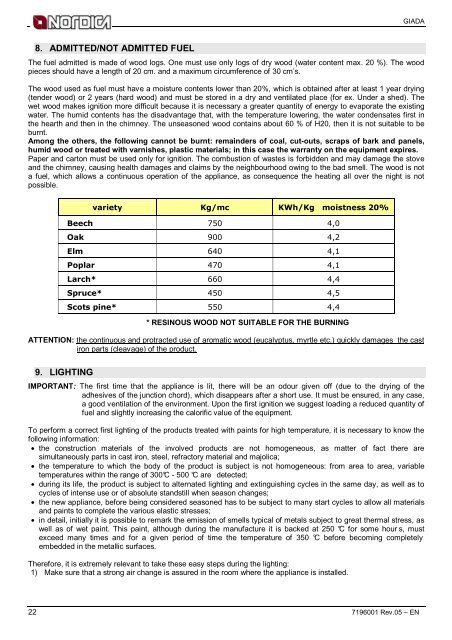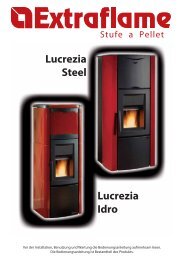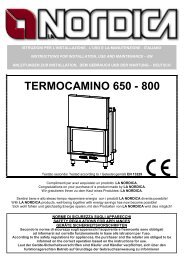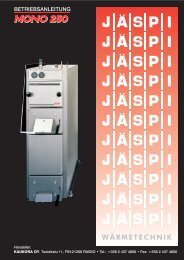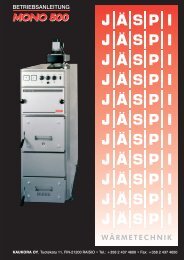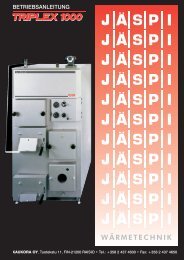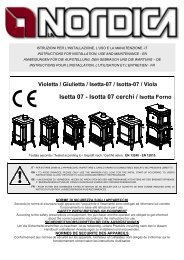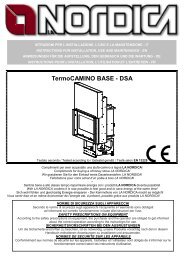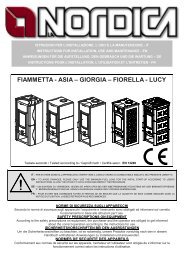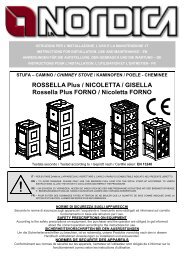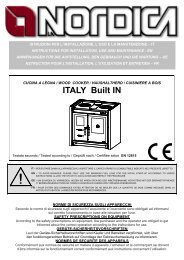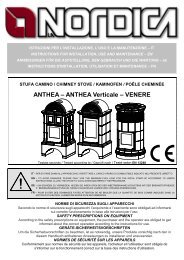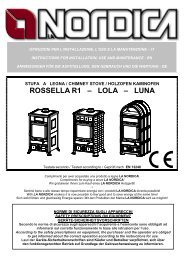giada
giada
giada
Create successful ePaper yourself
Turn your PDF publications into a flip-book with our unique Google optimized e-Paper software.
GIADA<br />
8. ADMITTED/NOT ADMITTED FUEL<br />
The fuel admitted is made of wood logs. One must use only logs of dry wood (water content max. 20 %). The wood<br />
pieces should have a length of 20 cm. and a maximum circumference of 30 cm’s.<br />
The wood used as fuel must have a moisture contents lower than 20%, which is obtained after at least 1 year drying<br />
(tender wood) or 2 years (hard wood) and must be stored in a dry and ventilated place (for ex. Under a shed). The<br />
wet wood makes ignition more difficult because it is necessary a greater quantity of energy to evaporate the existing<br />
water. The humid contents has the disadvantage that, with the temperature lowering, the water condensates first in<br />
the hearth and then in the chimney. The unseasoned wood contains about 60 % of H20, then it is not suitable to be<br />
burnt.<br />
Among the others, the following cannot be burnt: remainders of coal, cut-outs, scraps of bark and panels,<br />
humid wood or treated with varnishes, plastic materials; in this case the warranty on the equipment expires.<br />
Paper and carton must be used only for ignition. The combustion of wastes is forbidden and may damage the stove<br />
and the chimney, causing health damages and claims by the neighbourhood owing to the bad smell. The wood is not<br />
a fuel, which allows a continuous operation of the appliance, as consequence the heating all over the night is not<br />
possible.<br />
variety Kg/mc KWh/Kg moistness 20%<br />
Beech 750 4,0<br />
Oak 900 4,2<br />
Elm 640 4,1<br />
Poplar 470 4,1<br />
Larch* 660 4,4<br />
Spruce* 450 4,5<br />
Scots pine* 550 4,4<br />
* RESINOUS WOOD NOT SUITABLE FOR THE BURNING<br />
ATTENTION: the continuous and protracted use of aromatic wood (eucalyptus, myrtle etc.) quickly damages the cast<br />
iron parts (cleavage) of the product.<br />
9. LIGHTING<br />
IMPORTANT: The first time that the appliance is lit, there will be an odour given off (due to the drying of the<br />
adhesives of the junction chord), which disappears after a short use. It must be ensured, in any case,<br />
a good ventilation of the environment. Upon the first ignition we suggest loading a reduced quantity of<br />
fuel and slightly increasing the calorific value of the equipment.<br />
To perform a correct first lighting of the products treated with paints for high temperature, it is necessary to know the<br />
following information:<br />
• the construction materials of the involved products are not homogeneous, as matter of fact there are<br />
simultaneously parts in cast iron, steel, refractory material and majolica;<br />
• the temperature to which the body of the product is subject is not homogeneous: from area to area, variable<br />
temperatures within the range of 300°C - 500 °C are detected;<br />
• during its life, the product is subject to alternated lighting and extinguishing cycles in the same day, as well as to<br />
cycles of intense use or of absolute standstill when season changes;<br />
• the new appliance, before being considered seasoned has to be subject to many start cycles to allow all materials<br />
and paints to complete the various elastic stresses;<br />
• in detail, initially it is possible to remark the emission of smells typical of metals subject to great thermal stress, as<br />
well as of wet paint. This paint, although during the manufacture it is backed at 250 °C for some hour s, must<br />
exceed many times and for a given period of time the temperature of 350 °C before becoming completely<br />
embedded in the metallic surfaces.<br />
Therefore, it is extremely relevant to take these easy steps during the lighting:<br />
1) Make sure that a strong air change is assured in the room where the appliance is installed.<br />
22 7196001 Rev.05 – EN


